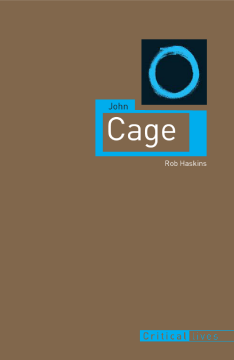
Additional Information
Book Details
Abstract
American writer, composer, artist, and philosopher John Cage (1912–92) is best known for his experimental composition 4’33,” a musical score in which the performer does not play an instrument during the duration of the piece. The purpose, Cage said, was for the audience to listen to the sounds of the environment around them while the piece was performed. Groundbreaking pieces such as 4’33”, as well as Sonatas and Interludes not only established Cage as a leading figure in the postwar avant-garde movement, but also cemented the enduring controversy surrounding his work.
In this new biography, Rob Haskins explores Cage’s radical approach to art and aesthetics and his belief that everyday life and art are one and the same. Scrutinizing Cage’s emphasis on chance over intention, which rejected traditional artistic methods and caused an uproar among his peers, Haskins elucidates the ideas that lay behind these pillars of Cage’s work. Haskins also demystifies the influence of Eastern cultures, particularly Zen Buddhism, on Cage, including his use of the Chinese text I Ching as his standard composition tool in all his work after 1951. Adding to our understanding of the art, music, and ideas of the twentieth century, this book provides an engaging look at a man who continues to challenge and inspire artists worldwide.“Haskins does a fine job of dealing with Cage’s many facets—his use of chance and thoughts about the ego and individualism, his flair for populism, his poetry and visual art—in much the same way he handles the Buddhist element: he deals with them intelligently and succinctly and then moves along. . . . Haskins does a laudably thorough job. It’s a quick, intelligent, and quite readable book.” — New Music Box
“[An] excellent introductory volume for the Reaktion Critical Lives series.” — Times Literary Supplement
“This excellent biography by Rob Haskins sweeps away any possibility of Cage being considered a joker. It illuminates the composer’s life and work and makes eminently clear the intellectual underpinning and circumstances of his multivarious activities. . . . This compact volume has plenty for the layperson and devotee alike. It is well laid out and the references and bibliography are excellent. The story of Cage’s life is fascinating and Haskins tells it well, clearly explaining the developments of the maverick composers musical ideas.” — BBC Music magazine
“Rob Haskin . . . shows, with an often lovely turn of phrase, how brilliantly—and profoundly musically—Cage was able to apply Zen to the process of writing music.” — Los Angeles Times
“[Haskins’] book is part of Reaktion Books’ Critical Lives series and is a miracle of concision. A mere 180 pages, the book not only tells the story of Cage’s eventful life but also explores the composer’s use of chance, his interest in Zen Buddhism and the I Ching, his painting and his writings. Haskins deals with each in a deceptively easy manner. On closer inspection, his discussions are clearly distillations of wide knowledge. References, internet links, exhibition catalogues, bibliography and select discography are all impeccably managed. . . . Coming to Cage’s output for the first time via Haskins would be an informative and life-enhancing experience. For those of us who came in altogether more random a fashion (surely Cage would have approved?), Haskins would have saved us a lot of time.” — Tempo
“Haskins’ style is pleasingly crisp and transparent—the complexities and subtleties to which Cage sometimes seems to adhere are always clearly explained; yet without simplification. Where examples help to explain, they are chosen. . . . An ideal introduction and companion to the work, thinking and to some extent the influence of a composer whose place in music is still being assessed. Recommended.” — Choice
“Rob Haskins’ John Cage is not just another book on Cage; in various ways, Haskins manages to include in only 154 pages of main text more than other authors have covered in toms with many more pages. . . . The narration flows extremely smoothly, and the book is a good and enjoyable read. However, Haskins goes far beyond this: he gives us deep insights into various aspects of Cage’s oeuvre, not only the musical works, in the narrow sense, but also the literary and poetic examples of his aesthetic thinking, as well as his numerous visual art objects. . . . This volume is a crucial contribution to Cage scholarship; in its compact form it should be bought by any library that wants to provide the best possible introduction to Cage’s oeuvre in all its expressions and manifestations.” — Notes
Rob Haskins is assistant professor in the Department of Music and the University of New Hampshire, Durham. He is the author of Anarchic Societies of Sounds: The Number Pieces of John Cage.
